‘Ajineh Mwarraqah
March 25th, 2009
‘Ajineh Mwarraqah means dough with many leaves / layers. It is a basic dough for many dishes in Hama, Aleppo and Idleb. The ingredients for the dough in Hama differ from Aleppo and Idleb but the method of preparation is the same, also it is used in same dishes which are: ‘Esh Al-Bulbul, Sambousek Mwarraq, Ozi, Sh’eibiyyat, Bsaisat / Twaitat. It’s a challenging recipe that requires time, some special techniques and a scale. The post is about the version of Hama.
Let’s make ‘Ajineh Mwarraqah:
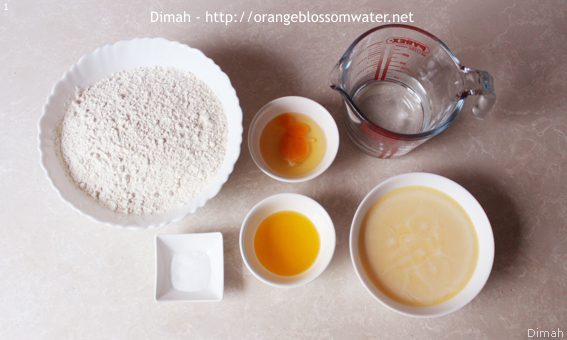
1. Ingredients for dough are: All purpose flour, salt, ghee, egg, and water. Ghee for the layers.
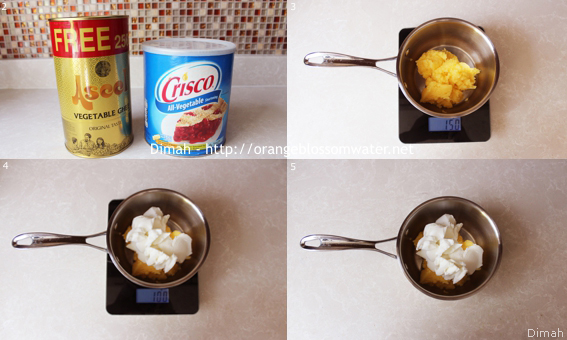
Tasmin
2. First to prepare ghee for the layers. Traditionally sheep’s suet or samneh Arabi (Syrian ghee made from sheep’s milk) are used. However, I use a mixture of vegetable ghee and Crisco all-vegetable shortening.
3, 4, 5. In a saucepan, measure 150 g vegetable ghee and 100 g Crisco all-vegetable shortening.
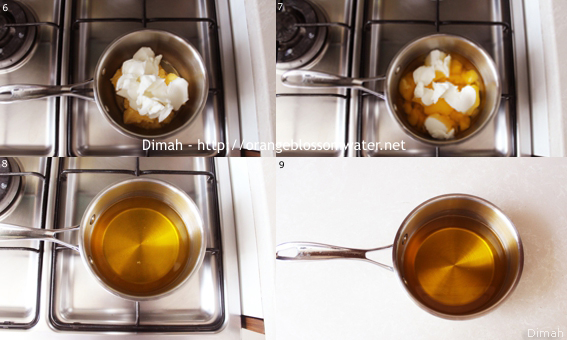
6, 7, 8, 9. Put the saucepan over medium heat and melt the mixture of ghee.
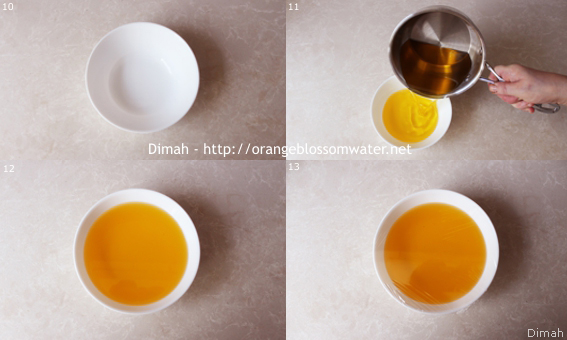
10, 11. Pour the melted ghee into a bowl.
12. Allow to slightly cool at room temperature.
13. Cover with a plastic wrap and put in the refrigerator for 24 hours.
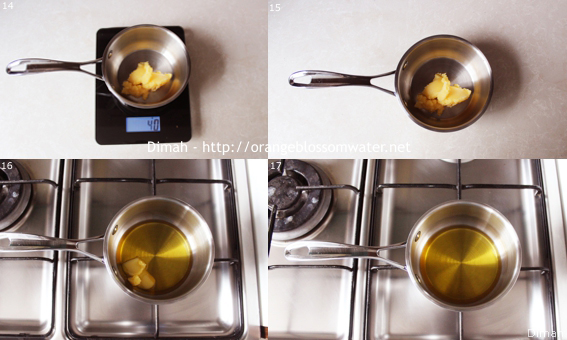
Dough (After 24 hours)
14. In a small saucepan, put 35 or 40 g ghee.
15, 16, 17. Put the saucepan over medium heat and melt ghee.
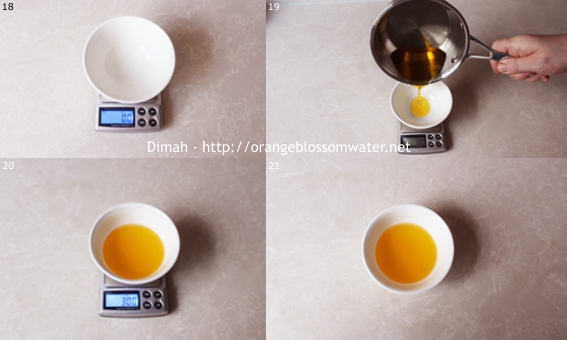
18, 19, 20, 21. In a bowl measure 30 g of melted ghee and set aside.
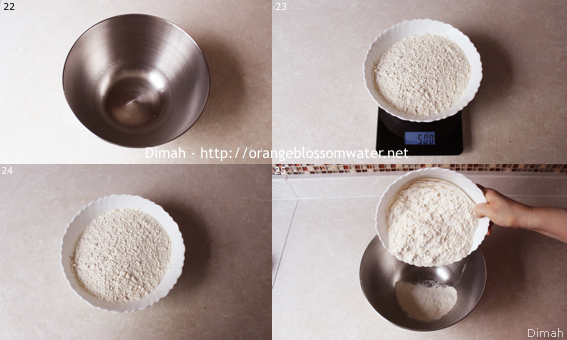
22, 23, 24, 25. Measure 500 g all purpose flour in the mixer bowl.
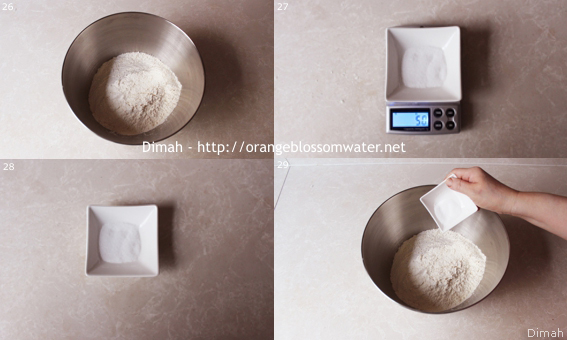
26, 27, 28, 29. Add 5 g salt to flour.

30, 31, 32, 33. Add 30 g melted ghee to dry ingredients.
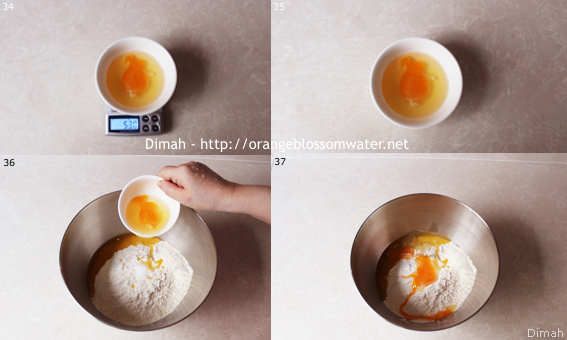
34, 35, 36, 37. Add 53 g egg to the ingredients in the mixer bowl.
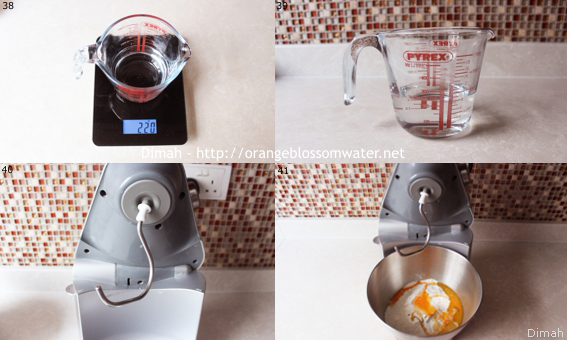
38, 39. Measure 220 g lukewarm water and set aside.
40, 41. Set the bowl in place and attach the dough hook to the mixer head.
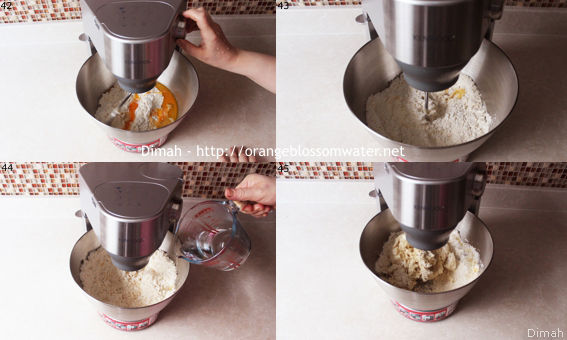
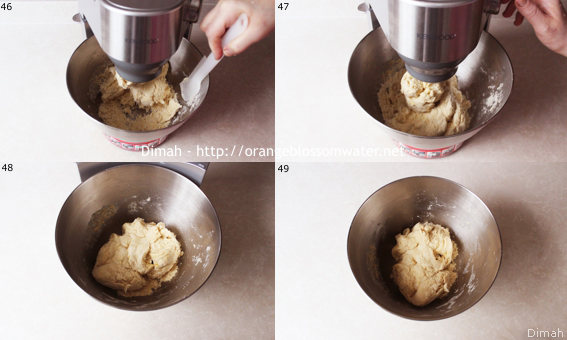
42 to 49. Turn the mixer on low speed to stir the ingredients. With the motor running, add 220 g lukewarm water and run the mixer, kneading until a mass of dough is formed.
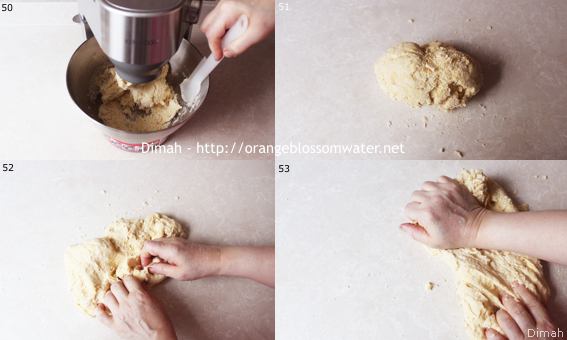
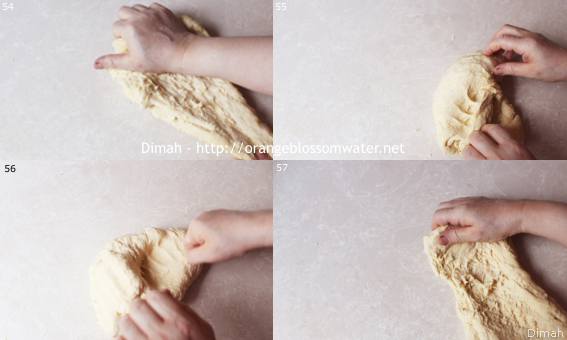
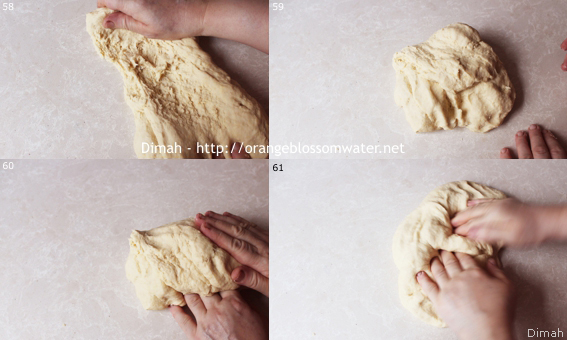
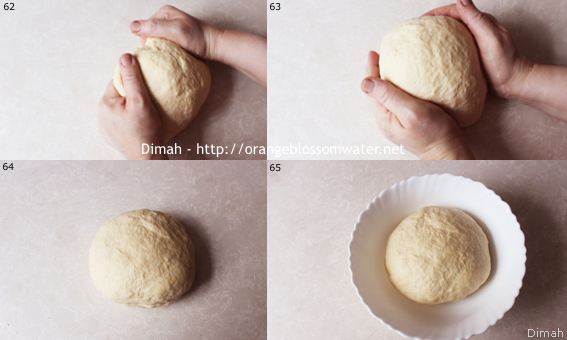
50, 51. Turn dough onto a counter.
52 to 64. Knead with hands until the dough is smooth elastic. Then shape it into a ball.
65. Place the dough in a bowl. Cover the bowl with plastic wrap and with a cloth. Keep the dough at room temperature for two hours to rest.
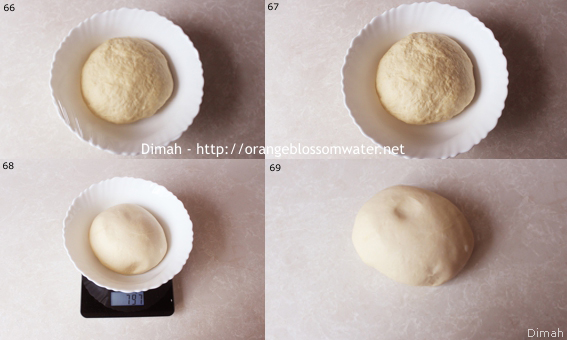
66, 67, 68. After two hours, bring the dough and weigh it. The weight of the dough is 797 g.
69. Turn dough onto a counter.
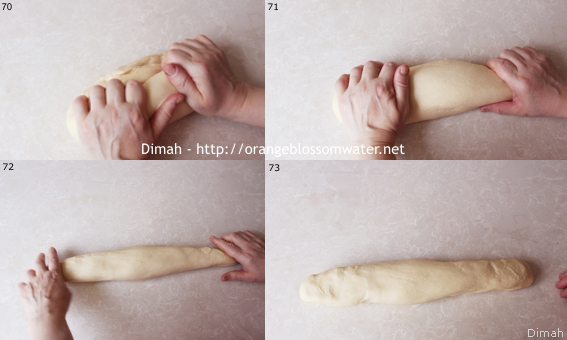
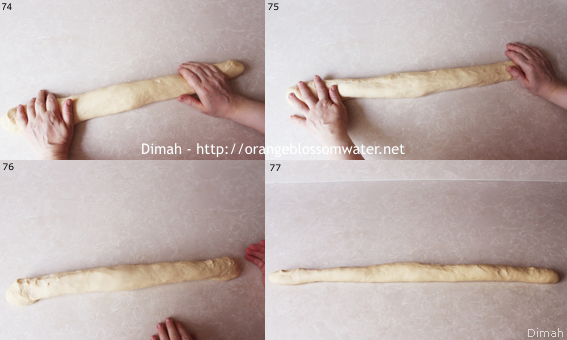
74, 75, 76, 77. Roll the dough into a log.
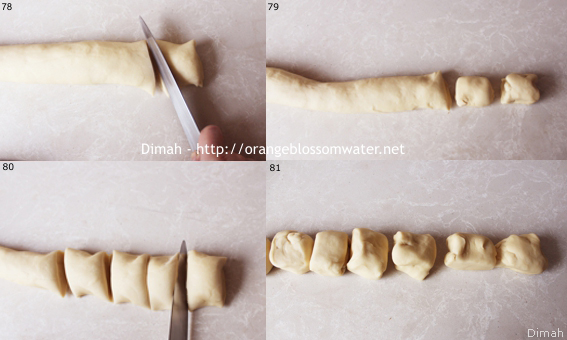
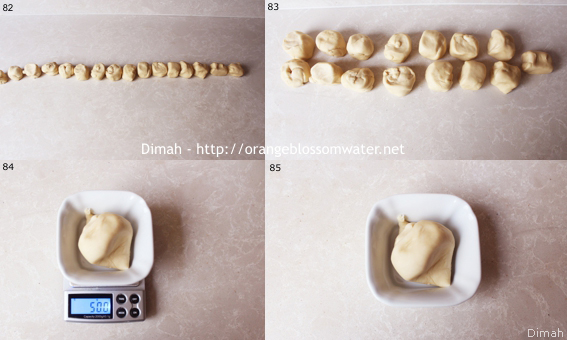
78 to 85. Cut the dough into equal pieces. The weight for each piece is 50 g. It can be made smaller (30 g) or bigger (75 g), but 50 g is the most preferable size. The number of pieces will be 16 pieces when each piece weighs 50 g. Keep the pieces of dough covered with a clean cloth to prevent drying out of them.
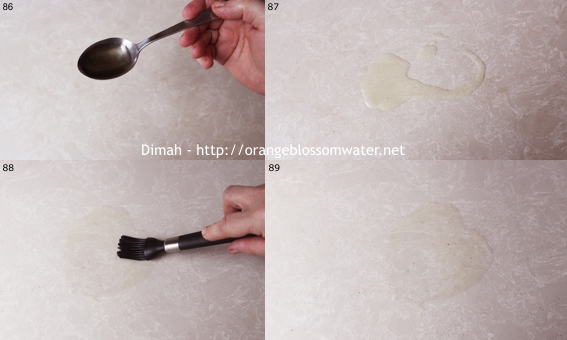
86, 87, 88, 89. Grease the counter with two tablespoons of corn oil.
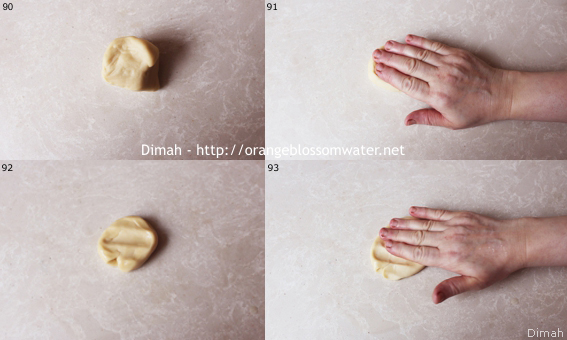
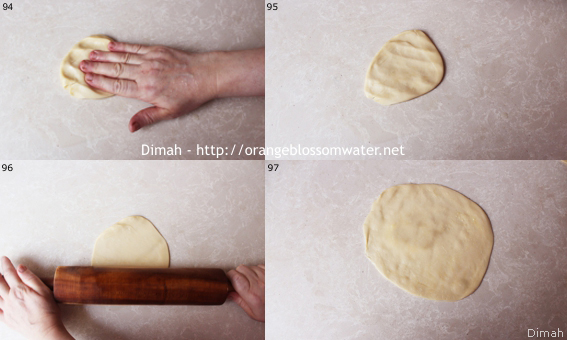
90, 91, 92, 93, 94, 95 . Put the piece of dough on oiled counter and flatten with hand. Keep the rest pieces of dough covered with a clean cloth to prevent drying out of them.
96, 97. Use a rolling pin to roll the dough to roll dough into circle with 6 inch (15 cm) diameter.
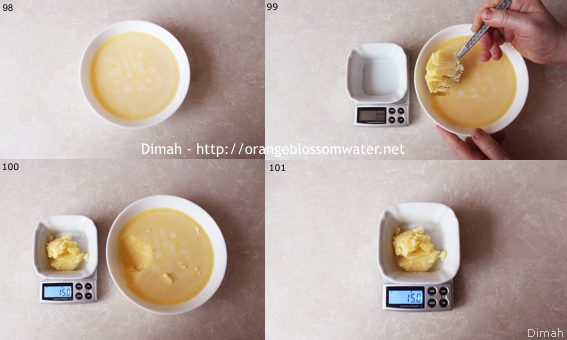
98. Bring the ghee mixture form the refrigerator. It will be used cold.
99, 100, 101. Measure 15 g ghee mixture.
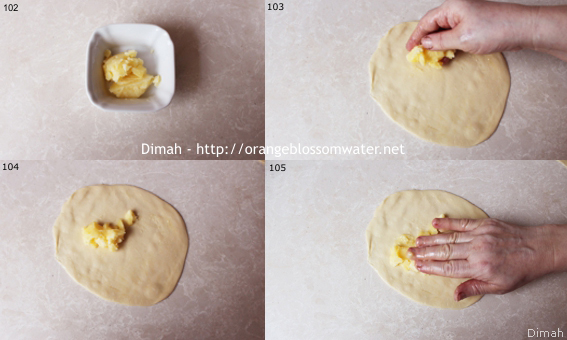
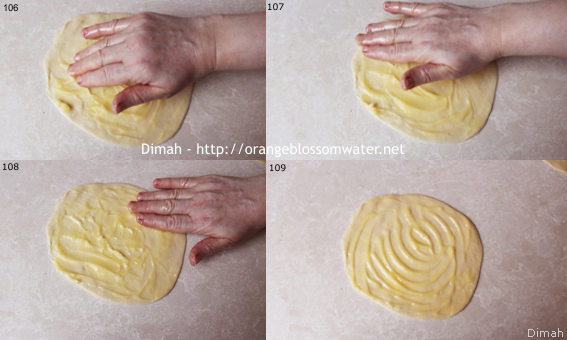
102 to 109. Take the 15 g of ghee mixture and spread most of it on the circle of the dough.
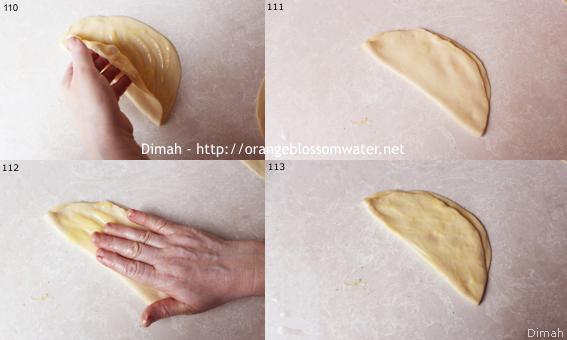
110. Pick up one side of the sides of the dough and fold it a half of the way over the rest of the dough. Take the rest of the ghee (the remained amount from the 15 g) and spread it on top of the dough. The method of adding ghee to dough is called “Tasmin”.
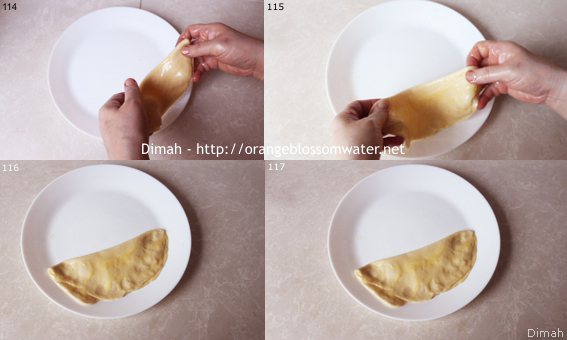
114, 115, 116, 117. Put the piece of dough on a plate.
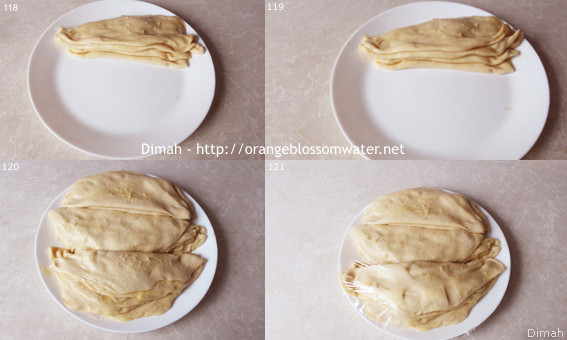
118. Repeat the above process with all the pieces of the dough. Use 15 g of ghee for each piece of dough that weighs 50 g.
119, 120. Stack the pieces of the dough on the plate. The maximum number in each stack is 5 pieces. Later each piece will be used by its own not as a stack.
121. Cover with plastic wrap and keep in the refrigerator for 1 hours.
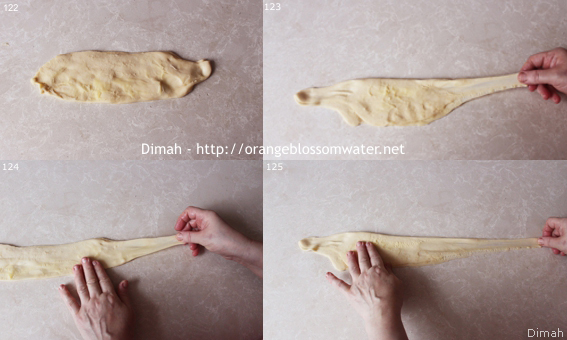
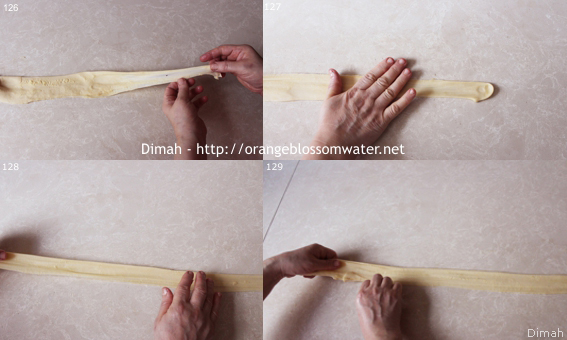
122. After 1 hour, take one piece of dough put it on counter.
123 to 129. Use both hands to work. Hold the dough and gently stretch with your fingers to 30 inch (80 cm) long and 1 inch (2 1/2 cm) wide. It is fine if the dough tears when stretching, just joint it and continue.
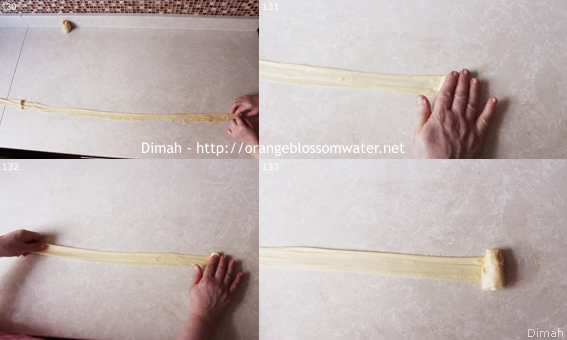
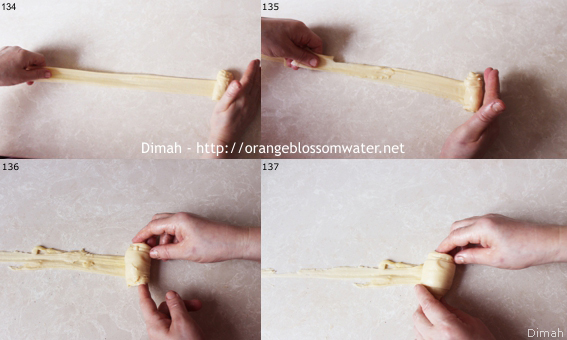
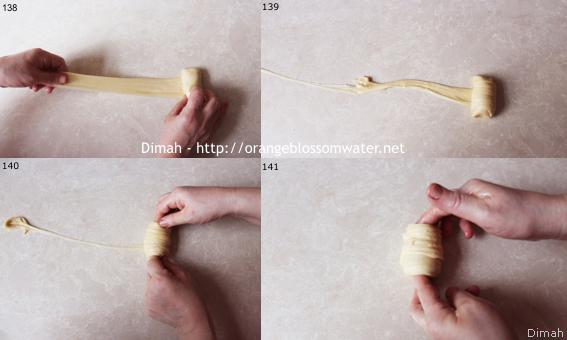
130 to 141. Use both hands. Hold the dough from one side and roll up the piece of dough tightly. Stretch it from one side (picture 134) while rolling it.
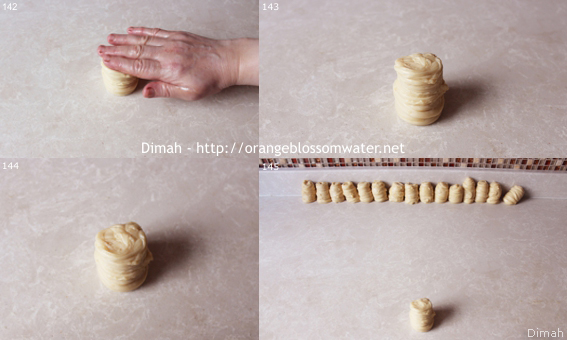
142, 143, 145. Press it gently, do not press too much, just like touching it.
146. Repeat the process with the remaining pieces. To remember, they are 16 pieces of dough, each piece weighs 50 g.
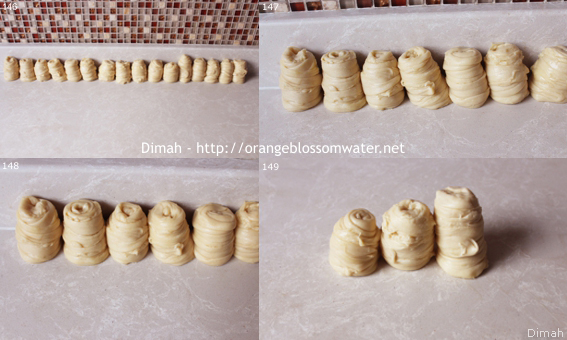
146, 147, 148. This is how the rolled dough awith many layers “Mwarraqah”.
149. This is a sample of different sizes. The right one is 75 g. The middle is 50 g, the last one is 30 g.
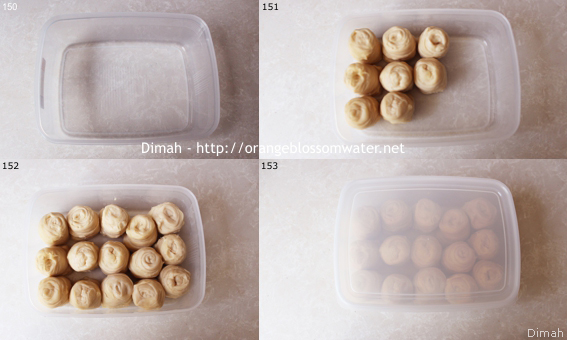
150, 151, 152, 153. Put the pieces of the in airtight container, make sure the container is big enough. The pieces should be kept standing up. Close the container. The dough can be used in same day but keep it in the refrigerator for an hour before using. On the other hand, the dough can be frozen but allow to thaw in the refrigerator before using.
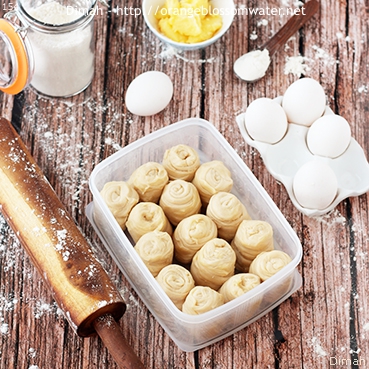
154. ‘Ajineh Mwarraqah. For clear details, check the video details under notes and tips.
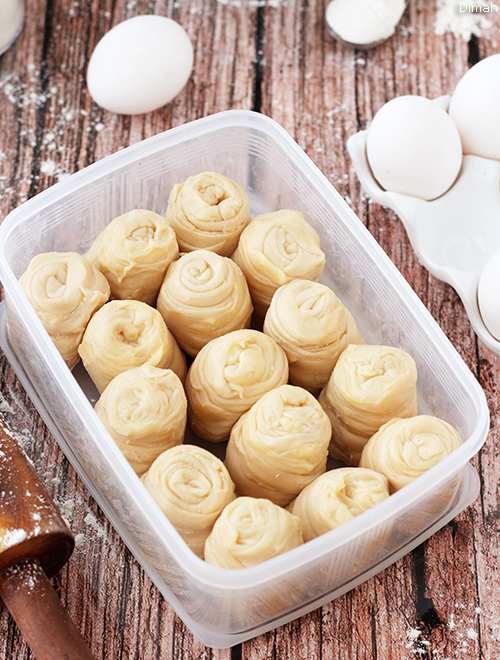
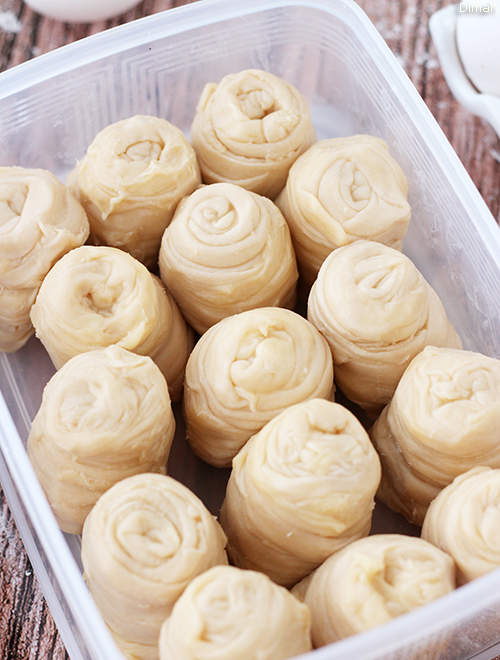
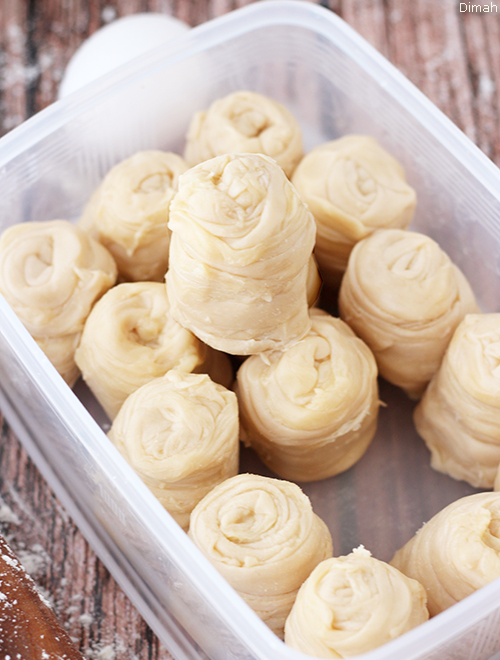
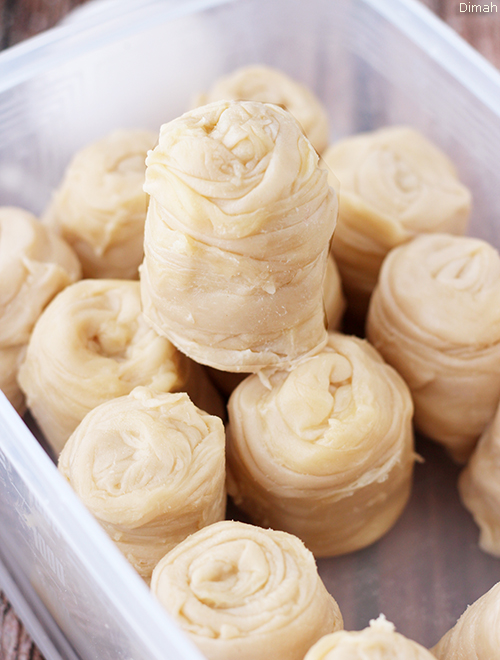
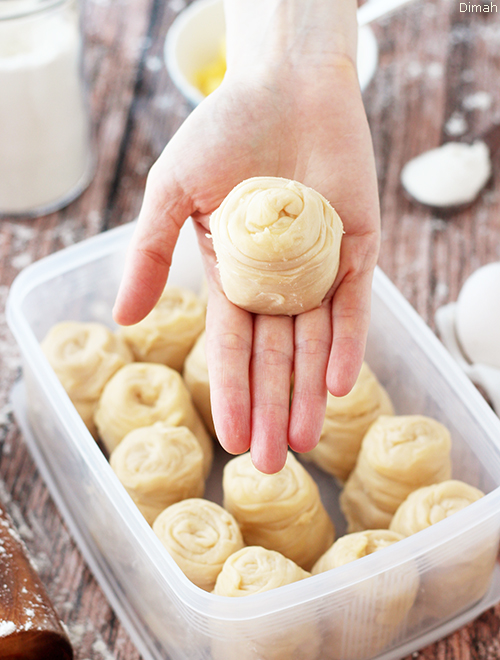
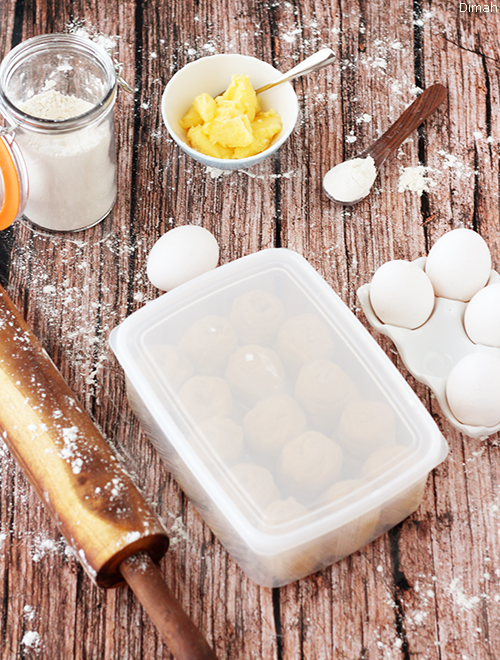
‘Ajineh Mwarraqah
From: Family Recipe / Servings: 16 pieces (each piece 50 g)
PDF Text Only / Print With Images
| Tasmin
150 g vegetable ghee
100 g Crisco all-vegetable shortening Dough 500 g all purpose flour 5 g salt 30 g melted ghee 53 g egg 220 g to 225 g lukewarm water corn oil, to grease the counter
|
Ingredients for dough are: All purpose flour, salt, ghee, egg, and water. Ghee for the layers
Tasmin First to prepare ghee for the layers. Traditionally lamb suet or Syrian Sheep’s milk ghee is used. However, I use a mixture of vegetable ghee and Crisco all-vegetable shortening. In a saucepan, measure 150 g vegetable ghee and 100 g Crisco all-vegetable shortening. Pour the melted ghee into a bowl. Allow to slightly cool at room temperature. Cover with a plastic wrap and put in the refrigerator for 24 hours. Dough (After 24 hours) In a small saucepan, put 35 or 40 g ghee. Put the saucepan over medium heat and melt ghee. In a bowl measure 30 g of melted ghee and set aside. Measure 500 g all purpose flour in the mixer bowl. Add 5 g salt to flour. Add 30 g melted ghee to dry ingredients. Add 53 g egg to the ingredients in the mixer bowl. Measure 220 g lukewarm water and set aside. Set the bowl in place and attach the dough hook to the mixer head. Turn the mixer on low speed to stir the ingredients. With the motor running, add 220 g lukewarm water and run the mixer, kneading until a mass of dough is formed. Turn dough onto a counter. Knead with hands until the dough is smooth elastic. Then shape it into a ball. Place the dough in a bowl. Cover the bowl with plastic wrap and with a cloth. Keep the dough at room temperature for two hours to rest. After two hours, bring the dough and weigh it. The weight of the dough is 797 g. Turn dough onto a counter. Roll the dough into a log. Cut the dough into equal pieces. The weight for each piece is 50 g. It can be made smaller (30 g) or bigger (75 g), but 50 g is the most preferable size. The number of pieces will be 16 pieces when each piece weighs 50 g. Keep the pieces of dough covered with a clean cloth to prevent drying out of them. Grease the counter with two tablespoons of corn oil. Put the piece of dough on oiled counter and flatten with hand. Use a rolling pin to roll the dough to roll dough into circle with 6 inch (15 cm) diameter. Bring the ghee mixture form the refrigerator. It will be used cold. Measure 15 g ghee mixture. Take the 15 g of ghee mixture and spread most of it on the circle of the dough. Pick up one side of the sides of the dough and fold it a half of the way over the rest of the dough. Take the rest of the ghee (the remained amount from the 15 g) and spread it on top of the dough. The method of adding ghee to dough is called “Tasmin”. Put the piece of dough on a plate. Repeat the above process with all the pieces of the dough. Use 15 g of ghee for each piece of dough that weighs 50 g. Stack the pieces of the dough on the plate. The maximum number in each stack is 5 pieces. Later each piece will be used by its own not as a stack. Cover with plastic wrap and keep in the refrigerator for 1 hour. After 1 hour, take one piece of dough put it on counter. Use both hands to work. Hold the dough and gently stretch with your fingers to 30 inch (80 cm) long and 1 inch (2 1/2 cm) wide.It is fine if the dough tears when stretching, just joint it and continue. Use both hands. Hold the dough from one side and roll up the piece of dough tightly. Stretch it from one side (picture 134) while rolling it. Press it gently, do not press too much, just like touching it. Repeat the process with the remaining pieces. To remember, they are 16 pieces of dough, each piece weighs 50 g. This is how the rolled dough with many layers “Mwarraqah”. This is a sample of different sizes. The right one is 75 g. The middle is 50 g, the last one is 30 g. Put the pieces of the in airtight container, make sure the container is big enough. The pieces should be kept standing up. Close the container. The dough can be used in same day but keep it in the refrigerator for two hours before using. On the other hand, the dough can be frozen but allow to thaw in the refrigerator before using. ‘Ajineh Mwarraqah. For clear details, check the video details under notes and tips. |
Notes and Tips
For Tasmin: Vegetable ghee can be use only but make sure to measure 250 g of it, or Crisco can be used only and also make sure to measure 250 g of it.
Dough can be made from the beginning without a mixer.
Animal ghee or vegetable ghee can be used for the 30 g melted ghee inside the dough, but do not use Crisco for this.
The size of the egg: 53 g is without shell, it can be used 53 g to 55 g. The size with shell is 60 g to 63 g. It is one large egg but measuring in grams is better.
The amount of lukewarm water is 220 g that is same as 220 ml. If you feel that the dough needs more water so add little, that depends on the flour itself. The dough at the end should be smooth and elastic.
For each 50 g piece of dough, you should use 15 g ghee. If you make the size of the pieces equals to 30 g so you have to use 9 g ghee. If you make the size of the pieces equals to 75 g so you have to use 22 g ghee.
The dough is used for making these dishes: ‘Esh Al-Bulbul, Sambousek Mwarraq, Ozi, Sh’eibiyyat, Bsaisat / Twaitat. I use the size 50 g of dough for making ‘Esh Al-Bulbul and Sambousek Mwarraq. Traditionally Sh’eibiyyat is made with size 75 g but I prefer to make it smaller with the size 30 g especially when I have guests.
The dough can be used in same day but keep it in the refrigerator for two hours before using. On the other hand, the dough can be frozen but allow to thaw in the refrigerator before using.
Check my video:
Making ‘Ajineh Mwarraqah
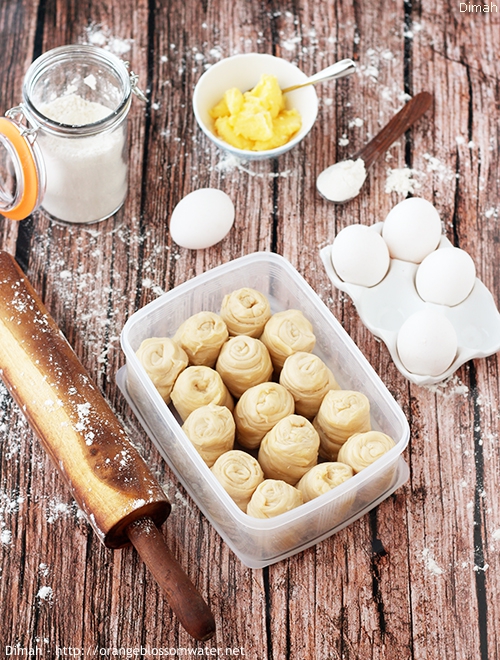
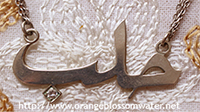
How interesting! I’ve never seen dough quite like this before. And your step-by-step photos make it look so easy, too.
Dimah, this sounds so interesting. Like Carolyn I’ve never seen a dough quite like this before. I want to wish you well in your continuing studies.
I have never seen that before, but it looks interesting.
Very interesting! Thanks for the informative post anf great recipe!
Cheers,
Rosa
Carolyn Jung: Thanks! great to hear from you again!
Mary: Thanks for your kind words! and welcome to my blog!
Kelly: Thanks!
Rosa: Thanks for stopping by!
I’ve never seen a dough like that before…very cool.
This is really interesting. I always learn something new whenever I visit your blog :)
hi dimah! i adore middle eastern culture and cuisine, so i’m so happy to have discovered your blog! no doubt i’ll be learning a lot from your recipes. post more syrian sweets, hee hee! :)
Jessica: Thanks for stopping by!
Jude: You are most welcome! and thank you!
HappyTummy: Welcome to my blog! and thanks for your interest and comment!
What an interesting dough. Thanks so much for the tutorial. I must try this some time!
OH Yummmmm! How long would you say it is good for in the Fridge? I have been getting a weird taste to some of my food…. like freezer burn! YUCK!
seasofsilver: you can keep it in the freezer for 3 or 4 months.
Congratulations for your beautiful blog.
Your recipies are very interesting. That kind of dough is really intriguing. In step 10 you cut the dough into pieces – how much do they weigh approx.?
I wish you all the best for your studies.
I like it that you include information about Syria in your blog.
Your First Lady is a true beauty!
Brigitta: Welcome to my blog! and thanks for your kind words.
Each piece weighs approx 50 g , but the weight is up to you, if less than 50 g you will get smaller pieces and more quantity, and more than 50 g you will get bigger pieces and less quantity.
Yes, Mrs.Asma is so beautiful and all Syrians respect her and love her :)
Keep in touch!
Dimah
I cannot find Smmneh Hamwiyeh in North Bay, I can make my own clarified butter, will it work without adding the Crisco
Arlette: the point is to use Crisco only, so either sammneh Hamwiyeh or Crisco.
The texture of the clarified butter must be similar to crisco, so you can spread it.
If your clarified butter is like a liquid, so put in the freezer for 30 minutes before using it in the dough.
If the clarified butter is soft but not liquid, so melt the clarified butter, then put in the freezer for 30 minutes before using it in the dough.
You need a texture like Crisco, so you will be able to spread the clarified butter.
My hats off to you my dear – I was searching esh al bulbul and I came across your website – what a detailed and well outlined description of how to make this pastry. I am really impressed by your discipline and desire to teach. God bless you.
Nice recipe. Can you explain why we should stretch the dough? What would happen if I don’t? Just interested in the reasoning :)